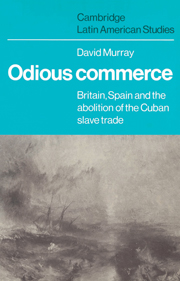Book contents
- Frontmatter
- Contents
- Tables
- Preface
- 1 The ‘opening’ of a legal trade
- 2 Parliament versus Cortes
- 3 Legality and illegality
- 4 The treaty of 1817
- 5 Enforcement and re-enforcement: the attempt to make the slave trade prohibition effective
- 6 The treaty of 1835
- 7 An abolitionist era
- 8 The Turnbull affair
- 9 The Escalera conspiracy
- 10 The penal law of 1845
- 11 Free trade and annexationism
- 12 The failure of the penal law
- 13 A new class of slaves
- 14 The abolition of the Cuban slave trade
- Abbreviations
- Notes
- Bibliography
- Index
- CAMBRIDGE LATIN AMERICAN STUDIES
1 - The ‘opening’ of a legal trade
Published online by Cambridge University Press: 16 October 2009
- Frontmatter
- Contents
- Tables
- Preface
- 1 The ‘opening’ of a legal trade
- 2 Parliament versus Cortes
- 3 Legality and illegality
- 4 The treaty of 1817
- 5 Enforcement and re-enforcement: the attempt to make the slave trade prohibition effective
- 6 The treaty of 1835
- 7 An abolitionist era
- 8 The Turnbull affair
- 9 The Escalera conspiracy
- 10 The penal law of 1845
- 11 Free trade and annexationism
- 12 The failure of the penal law
- 13 A new class of slaves
- 14 The abolition of the Cuban slave trade
- Abbreviations
- Notes
- Bibliography
- Index
- CAMBRIDGE LATIN AMERICAN STUDIES
Summary
From the middle of the eighteenth century Cuba began to experience the remarkable economic growth which was to transform the island from a relative backwater of Spain's colonial empire into the world's richest colony and leading sugar producer by the late 1820s. Cuba's importance to Spain hitherto had arisen chiefly from the strategic geographical location of its main port and capital, Havana, the traditional rendezvous for Spanish treasure ships on their way back to the peninsula. Prior to 1763 Cuba's economy was a mixed agricultural one based on tobacco, sugar and cattle grazing. Cuba was not yet dependent on sugar as were the other major Caribbean islands, Jamaica, Barbados and St Domingue. Even in the 1750s, however, the seeds of the later sugar latifundia were germinating; in spite of a tobacco boom the number of sugar plantations was growing. Cuba's sugar revolution occurred in the years after 1763. The official export figures of sugar from Havana offer dramatic evidence of sugar's conquest of Cuba. A yearly average of 13,000 boxes of sugar left Havana in 1760–3, rising to 50,000 boxes in 1770–8 and to over 80,000 in 1778–96. Yearly averages from 1796 to 1800, amounting to nearly 135,000 boxes a year, illustrate how well Cuba capitalized on the vacuum created by the devastation of St Domingue.
The French colony of St Domingue had been the leading sugar producer in the Caribbean prior to the French Revolution, but the Revolution in 1789 set off a series of slave rebellions in the island which escalated into civil and race war, destroying the island's economy but leading eventually to the creation of Haiti, the first independent, black republic in the Caribbean.
- Type
- Chapter
- Information
- Odious CommerceBritain, Spain and the Abolition of the Cuban Slave Trade, pp. 1 - 21Publisher: Cambridge University PressPrint publication year: 1981

